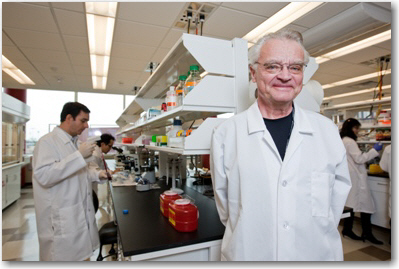Many diseases of brain function, such as epilepsy and schizophrenia, are caused by problems in how neurons communicate with each other. A University of Houston (UH) researcher and his team are analyzing these commands and connections in an attempt to prevent those diseases.
Dr. Jan-Åke Gustafsson, Robert A. Welch Professor in UH's biology and biochemistry department, describes his team's findings in a paper titled "Liver X receptor β and thyroid hormone receptor α in brain cortical layering," appearing in the current online issue of the journal Proceedings of the National Academy of Sciences, one of the world's most-cited multidisciplinary scientific serials.
"The brain works like a computer," said Gustafsson, who also is director of the Center for Nuclear Receptors and Cell Signaling at UH. "We know something about the hard wire, but so far we know nothing about ‘wireless connections.' Our work is about how and when the components of the ‘computer' are assembled and how the connections between the components are made."
The brain is composed of brain cells, called neurons, which are placed in the correct position in the brain during fetal and infant development. The neurons move with military precision to their correct places just like soldiers in a military parade, except the ranks are referred to as layers. If any of the neurons fail to make the correct move then there will be gaps in the formation of the cortex, which is the outer brain layer. Any distractions that slow down or speed up the neurons will cause a problem with the formation of the cortex. Normally, the neurons obey several commands that come from the environment, hormones and other nearby neurons.
"Like a computer, such connections determine how fast we think and how good our memories are, but also whether we will develop diseases like epilepsy or schizophrenia," he said. "Since the commands to the neurons come from hormones and environmental pollutants, it is essential that we understand how the commands are given and received if we are going to prevent those diseases, which appear to be due to the incorrect positioning of neurons."
Liver X and thyroid hormone receptors, which were studied for this paper, have been found to be essential to the developing cortex in mouse embryos and thereby sometimes regulate the same genes. The first part of the paper explains the importance of the liver X receptor, or LXR, which has been shown to be an important factor in brain development and, very likely, in neurological diseases. LXR plays key roles in cholesterol regulation and the central nervous system, regulating brain cholesterol levels, as well as in maintenance of motor neurons in the spinal cord. Gustafsson said the LXR belongs to a gene family called nuclear receptors that is akin to a "military division." If the LXR "commander" is taken away, the neurons under its command do not move. The second part of the paper says another "commander," called a thyroid hormone receptor, can later wake up the neurons that have stopped on the way and make them move again so that the formation of the cortex is restored.
The research team analyzed the architecture of the cerebral cortex in embryonic and neonatal mice, removing different receptors through genetic manipulation. When they want to find out the function of a gene, they use knockout technology to inactivate it, or knock it out. The process involves inserting a mistake into the gene. Since the genes in mice have similar functions in humans, the researchers can obtain information about what causes human diseases.
In addition to Gustafsson, the UH team consists of post-doc students Dr. Xin-jie Tan, Dr. Hyun-jin Kim, graduate student Ryan Butler and professor Margaret Warner. Additional collaborators include scientists from the Third Military Medical University in China, Methodist Hospital Research Institute in Houston and the Center for Biosciences at the Karolinska Institute in Sweden.
###
About the University of Houston
The University of Houston is a comprehensive national research institution serving the globally competitive Houston and Gulf Coast Region by providing world-class faculty, experiential learning and strategic industry partnerships. UH serves 37,000 students in the nation’s fourth-largest city in the most ethnically and culturally diverse region in the country.
About the College of Natural Sciences and Mathematics
The UH College of Natural Sciences and Mathematics, with 181 ranked faculty and approximately 4,500 students, offers bachelor’s, master’s and doctoral degrees in the natural sciences, computational sciences and mathematics. Faculty members in the departments of biology and biochemistry, chemistry, computer science, earth and atmospheric sciences, mathematics and physics conduct internationally recognized research in collaboration with industry, Texas Medical Center institutions, NASA and others worldwide.
For more information about UH, visit the university’s Newsroom at http://www.uh.edu/news-events/.
To receive UH science news via e-mail, visit http://www.uh.edu/news-events/mailing-lists/sciencelistserv/index.php.
For additional news alerts about UH, follow us on Facebook and Twitter.
